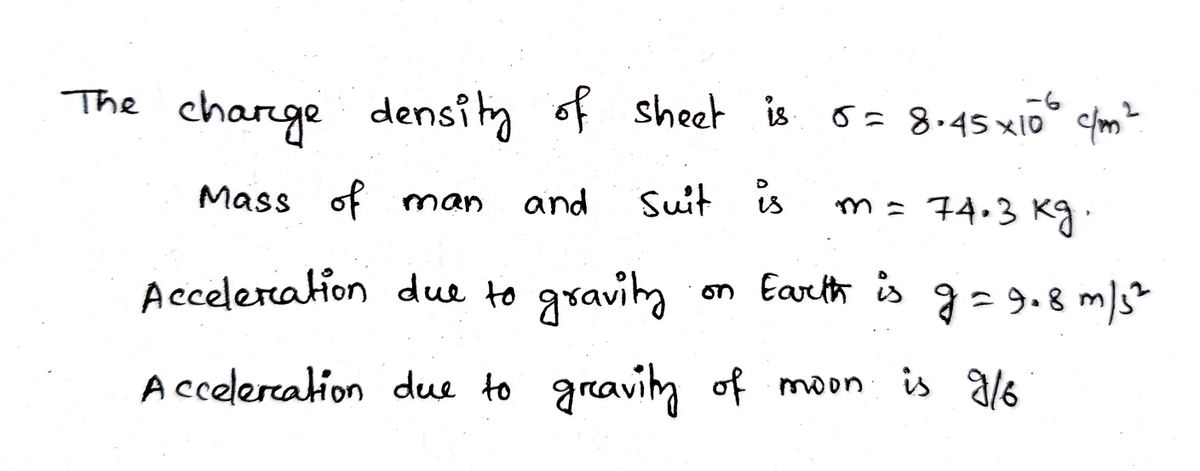
Concept explainers
Imagine that you’ve been invited to try out a new hoversuit , and here's how it works: Someone has set
up a large flat sheet, many kilometers across, somewhere on the Earth, and they’ve charged the sheet
up to a uniform charge density of 8.45 x 10^-6 C. You are issued a special suit that you wear, and it has
controls on it which allow you to charge the suit up to any number of Coulombs (C), positive or negative,
that you might want. The idea is that you can control the amount of electrical repulsion (or attraction)
between the suit and the charged sheet below you. Your mass including the suit is 74.3 kg. How much
charge must you give the suit if you want to fall down toward the sheet, but at the same rate as if you
were on the Moon (remembering that the gravitational acceleration on the Moon is 1/6 what it is on
Earth)?
1.27E-03 C
1.78E-03 C
1.91E-03 C
2.29E-03 C

Step by stepSolved in 4 steps with 4 images

- Imagine that you’ve been invited to try out a new hoversuit , and here's how it works: Someonehas set up a large flat sheet, many kilometers across, somewhere on the Earth, and they’vecharged the sheet up to a uniform charge density of 7.63 x 10^-6 C. You are issued a special suitthat you wear, and it has controls on it which allow you to charge the suit up to any number ofCoulombs (C), positive or negative, that you might want. The idea is that you can control theamount of electrical repulsion (or attraction) between the suit and the charged sheet belowyou. Suppose your mass (including the suit) is 62.8 kg. How much charge must you give the suitif you want to be able to just hover stationary above the charged sheet?1.43E-03 C4.29E-04 C2.15E-03 C2.29E-03 Carrow_forwardAir breaks down (loses its insulating quality) and sparking results if the field strength is increased to about 3.0 x 106 N/C. a) What acceleration does an electron experience in such a field (me=9.11x10’31kg)? (b) if the electron starts from rest, in what distance does it acquire a speed equal to 10% of the speed of light (3x107 m/s)?arrow_forwardWhat charge is required to produce a repulsive force of 10 microNewtons on a charge q= 4.5 nanoC that is 5.0 m away?arrow_forward
- 9. Imagine that you ve been invited to try out a new hoversuit , and here s how it works: Someone has set up a large flat sheet, many kilometers across, somewhere on the Earth, and they ve charged the sheet up to a uniform charge density of 8.52 x 10^-6 C, and your mass including the suit is 87.0 kg. You are issued a special suit that you wear, and it has controls on it which allow you to charge the suit up to any number of Coulombs (C), positive or negative, that you might want. The idea is that you can control the amount of electrical repulsion (or attraction) between the suit and the charged sheet below you. How much charge must you give the suit if you want to fall down toward the sheet, but at the same rate as if you were on the Moon (remembering that the gravitational acceleration on the Moon is 1/6 what it is on Earth)? 2.07E-03 C 2.37E-03 C 2.66E-03 C 1.48E-03 Carrow_forwardCalculate the work required to bring a charge of 5.9×10−95.9×10−9 C from infinity to a point 28.7 cm from a charge of 0.0390.039 μμC in vacuum. Use the value of Coulomb's constant ke=14πε0=9×109ke=14πε0=9×109 m/F. Provide your answer in units of 10−610−6 J: for example, if your answer is 3.6×10−63.6×10−6, then enter 3.6 as your answer.arrow_forwardA particle 1 has a mass of 9.11 x 10^-31 kg and a charge of +1.60 x 10^-19 C. Suppose this particle 1 moves near a particle 2 that has a charge of +3.20 x 10^- 19 C and at all times remains at rest. When particle 1 is 1.4 x 10^-10 m away from particle 2, it is moving away with a speed of 3 x 10^6 m/s. What is the speed of particle 1 when it is a distance of 3.6 x 10^-10 m from particle 2? Answer in mm/s and with two decimal places.arrow_forward
 College PhysicsPhysicsISBN:9781305952300Author:Raymond A. Serway, Chris VuillePublisher:Cengage Learning
College PhysicsPhysicsISBN:9781305952300Author:Raymond A. Serway, Chris VuillePublisher:Cengage Learning University Physics (14th Edition)PhysicsISBN:9780133969290Author:Hugh D. Young, Roger A. FreedmanPublisher:PEARSON
University Physics (14th Edition)PhysicsISBN:9780133969290Author:Hugh D. Young, Roger A. FreedmanPublisher:PEARSON Introduction To Quantum MechanicsPhysicsISBN:9781107189638Author:Griffiths, David J., Schroeter, Darrell F.Publisher:Cambridge University Press
Introduction To Quantum MechanicsPhysicsISBN:9781107189638Author:Griffiths, David J., Schroeter, Darrell F.Publisher:Cambridge University Press Physics for Scientists and EngineersPhysicsISBN:9781337553278Author:Raymond A. Serway, John W. JewettPublisher:Cengage Learning
Physics for Scientists and EngineersPhysicsISBN:9781337553278Author:Raymond A. Serway, John W. JewettPublisher:Cengage Learning Lecture- Tutorials for Introductory AstronomyPhysicsISBN:9780321820464Author:Edward E. Prather, Tim P. Slater, Jeff P. Adams, Gina BrissendenPublisher:Addison-Wesley
Lecture- Tutorials for Introductory AstronomyPhysicsISBN:9780321820464Author:Edward E. Prather, Tim P. Slater, Jeff P. Adams, Gina BrissendenPublisher:Addison-Wesley College Physics: A Strategic Approach (4th Editio...PhysicsISBN:9780134609034Author:Randall D. Knight (Professor Emeritus), Brian Jones, Stuart FieldPublisher:PEARSON
College Physics: A Strategic Approach (4th Editio...PhysicsISBN:9780134609034Author:Randall D. Knight (Professor Emeritus), Brian Jones, Stuart FieldPublisher:PEARSON





